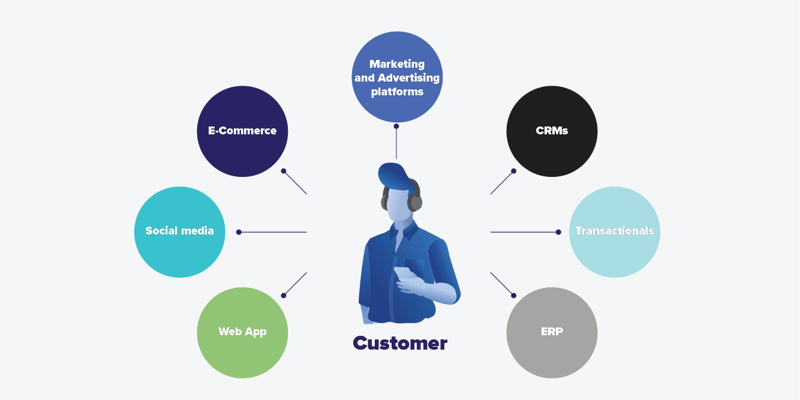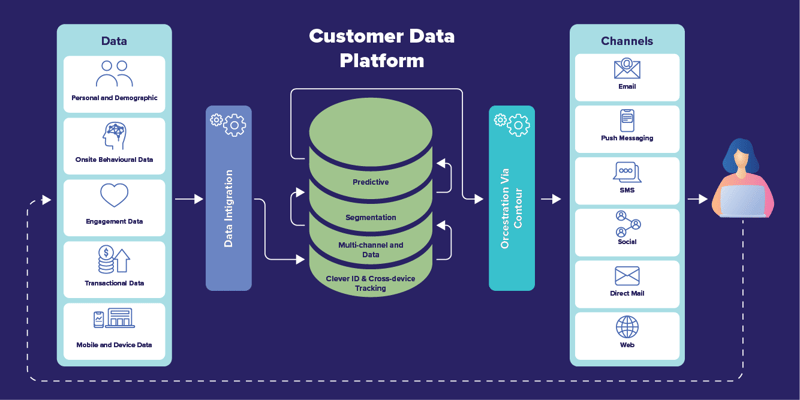With the surge in user devices and marketing tools growing every year, there is a need for businesses to go beyond traditional CRMs and invest more resources and tools to make sense out of the customer data generated from multiple sources.
Businesses face a challenge to decipher the clear picture of the customer information with data incoming from disparate systems.
This leads to building inefficient customer journeys. Even the customers are equally tired of these fragmented and impersonal experiences. In this backdrop, it’s unsurprising that Customer Data Platforms (CDP) are on the verge of shifting from a “nice-to-have” to a “need-to-have” technology.
CDP Institute defines a CDP as “A Customer Data Platform is packaged software that creates a persistent, unified customer database that is accessible to other systems”
In this blog, we describe how Marketing teams can benefit from a CDP.
What is a CDP for?
A CDP holds customer data. From a marketing perspective the idea is to consolidate all customer-related data into one platform; analyze them to gain a better understanding of the customer; enable the marketing teams to run appropriate campaigns and offers; enable targeted advertisements.
What sort of Customer data?
Data collected across various touchpoints like POS in stores, websites, mobile apps, marketing lists, social media, contains the details given below:
- Registration data (basic details like name, contact info, gender, etc.)
- Communication and Notification preferences
- Demographics (age range, gender, region/market, income range, etc.)
- Transactions and Payment preferences
- Website and App activity (searches, views of, time spent, clicks, journey, browser, IP metadata, etc.)
- Complaints and feedback, call center and chat interactions, NPS scores
- Social media interactions
- Marketing and Campaign data and their interactions and responses (impressions, engagement, etc.)
-1.png?width=800&name=image%20(6)-1.png) This information forms the basis of building ‘customer profiles or personas’.
This information forms the basis of building ‘customer profiles or personas’.
Who are these “Customers”?
Typical personas that are aggregated in a CDP are:
- New users on website /app
- Anonymous returning users
- Registered users/customers
- New users — Marketing lists where campaigns had gone to, and they had responded or viewed
How do you bring in all the Customer data?
As the data is available in multiple systems in silos, there is a need to connect the systems for better visibility. This can be done by using connectors.
Businesses can use built-in connectors that come with mature CDPs or use APIs to build custom connectors.
What other systems?
Any system having Customer data of interest (a few are listed below). 
- Marketing and Advertising platforms
- Customer Relationship Management (CRM) systems
- e-Commerce systems
- ERP systems
- Transactional systems
- Web applications / Portals thru’ embedded analytics scripts
- Social media platforms
Building 360-Degree Customer View
Data is linked together to build a Customer 360 view for each customer. This provides a view of the customer across all channels and touchpoints. And, building this view needs quite a few things:
- cleansing the data
- data deduplication
- enriching the data
- unifying/merging the data for each customer
In most cases, the above is where the complexity is.
What can you get out of the customer's 360-degree view?
It shows how a customer has interacted with the brand in the past and present and deduces how they would interact in the future. Analyze the data and use it to deliver effective Marketing and User Experiences across channels.
Some of the analytics performed are:
- Slice and dice customer data to understand them more; Summarise and Aggregate; Explore customer data in detail
- Behavioral analytics — buying and usage patterns
- Apply Machine Learning algorithms to understand patterns, and predict behavior
- Customer segmentation — Group customers into segments based on their behavior and perform cohort analysis over time
- Build Propensity models to understand the likelihood to buy
Once we perform analytics, how do we use the information gained?
We can use the above analysis to then orchestrate Campaigns, Targeted Offers, Advertisements, etc. thru’ various channels.
Why do we need to do these on the CDP data?
The data is used for various use cases to accelerate revenues by:
- providing a personalized experience to customers across different touchpoints up-sell and cross-sell of products/services
- increased conversion rates
- enabling customers to find easily what they are looking for (or what they may need) customer satisfaction
We saw what a CDP is, what kind of data it holds, where it gets the data from, how the customer view is built and what analytics are performed, and finally how all of this is useful for the business. We can’t wait to see what’s next.
Our Services
Customer Experience Management
- Content Management
- Marketing Automation
- Mobile Application Development
- Drupal Support and Maintanence
Enterprise Modernization, Platforms & Cloud
- Modernization Strategy
- API Management & Developer Portals
- Hybrid Cloud & Cloud Native Platforms
- Site Reliability Engineering




